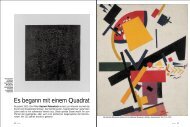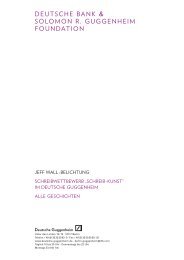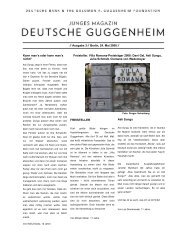DG Magazin - Deutsche Guggenheim
DG Magazin - Deutsche Guggenheim
DG Magazin - Deutsche Guggenheim
Erfolgreiche ePaper selbst erstellen
Machen Sie aus Ihren PDF Publikationen ein blätterbares Flipbook mit unserer einzigartigen Google optimierten e-Paper Software.
On View<br />
Links und rechts<br />
Above and right:<br />
Agathe Snow at the<br />
Acropolis, Athens<br />
AM: Meinst du, dass die meisten Denkmäler sich etwas vormachen<br />
mit dem, was sie zu tun scheinen, gegenüber dem, was<br />
sie wirklich tun? Ein Obelisk, eine klassische aufrechte Erektion,<br />
scheint so viel Glauben an die eigene Bedeutung zu haben, aber<br />
was nach Macht aussieht, könnte ja auch Hilflosigkeit sein.<br />
AS: Denkmäler widersprechen sich selbst. Dinge, die vom Akt<br />
der Erinnerung abhängig sind, können nicht statisch sein. Wie<br />
kann man aus einem bestimmten Punkt in der Geschichte stammen<br />
und dabei die Zeitlosigkeit ansprechen?<br />
AM: Es ist so, als wenn man glaubt, die Gegenwart ist wichtig<br />
und allmächtig, gegenüber dem Gedanken, dass sich jeder Moment<br />
aus allen Momenten zusammensetzt. Aber wenn man etwas<br />
herstellt, um die Gegenwart zu kennzeichnen, impliziert man<br />
damit eine Zukunft?<br />
AS: Ich bin mir nicht sicher. Wenn ich fände, die Gegenwart<br />
ist es wert, gekennzeichnet zu werden, dann würde ich mir wohl<br />
© Agathe Snow. Photo: Anthony Holbrooke<br />
than Paris? Why are so many monuments in Jerusalem? Why can’t<br />
you just break them apart and share them better?<br />
AM: Is there a social responsibility to make them accessible?<br />
AS: I wanted to connect with the largest amount of people<br />
and found a hook for building a conversation about monuments<br />
by simplifying the sales relationship between artist and buyer. Just<br />
come to our showroom at the <strong>Deutsche</strong> <strong>Guggenheim</strong> and create<br />
a custom order from the catalogue, and I promise to make<br />
these works for the next couple of years.<br />
When I think of monuments, I hear Elizabeth Taylor’s voice in<br />
Who’s Afraid of Virginia Woolf? (1966), “What a dump, WHAT A<br />
DUMP.” History, the human story, accumulates great achievements<br />
and unpredictable events, with monuments as a shorthand<br />
for all of it. In an interview you did about Fresh Hell (2010–11),<br />
which you curated for the Palais de Tokyo in Paris, you say that as<br />
a maker of things, you feel the weight of history and see death<br />
ahead of you. But, somehow you conclude that since all has<br />
already been done, let’s get to work. I also feel defiant of history:<br />
the more I want to learn, the more I face its depth and constant<br />
breaks and starts. History repeats itself is what you are told; yet,<br />
monuments mark all that is not repeated, all that is assumed to<br />
be unique and supreme. They claim that the world stopped with<br />
them and that nothing was more important than the accomplishments<br />
they represent.<br />
AM: Do you think most monuments are deluded in what they<br />
appear to be doing versus actually doing? An obelisk, a classic<br />
stand-up erection, seems to have such faith in its own meaning,<br />
but what seems to be power might also be desperation.<br />
AS: Monuments are a contradiction. Things that depend on<br />
the act of remembering cannot be static. How can you be of a<br />
moment in history yet speak of timelessness?<br />
© Agathe Snow. Photo: Anthony Holbrooke<br />
wünschen, dass alles da aufhört, dass es das Ende der Zeit ist.<br />
Wenn man die Gegenwart dadurch kennzeichnet, dass man etwas<br />
herstellt, richtet man sich wahrscheinlich nur an die Leute,<br />
mit denen man den Moment teilt.<br />
AM: Befinden wir uns vielleicht in einem ständigen Prozess<br />
des Gegenwartsverlustes, des Realitätsschwunds – jede Sekunde<br />
eine Apokalypse? Ich denke da an deine Skulptur The Whale<br />
(2007) und das Szenarium mit der überschwemmten Stadt, und<br />
dass Denkmäler auch die Dinge sind, die bleiben. Wenn eine Flut<br />
zurückgeht, stehen da wahrscheinlich einige Denkmäler herum.<br />
AS: Wie sie es ja auch immer wieder tun. Vielleicht ist es an der<br />
Zeit, die Denkmäler dadurch zu befreien, dass man sie einsperrt:<br />
in eine geschlossene Anstalt mit Wänden und einem Dach da-<br />
rüber. All Access World befürwortet so eine Möglichkeit. Das<br />
Pergamonmuseum in Berlin liefert ein gutes Argument für organisierte<br />
Plünderungen und die Präsentation von Denkmälern in<br />
Ausstellungsräumen. In wessen Obhut sollte man sie sonst geben –<br />
die eines internationalen Komitees vielleicht? Wer verspricht, sich<br />
am besten um sie zu kümmern? Oder vielleicht sollte man sie<br />
zerteilen, katalogisieren und in eine durchsichtige Kiste stecken,<br />
damit man die erbosten Nationalisten beruhigen kann, die ihre<br />
Denkmäler wiederhaben wollen? Wie wäre es, wenn man sie für<br />
ein paar Jahre wegpackt, um zu sehen, wie sehr sie vermisst werden,<br />
warum und von wem? Was wäre, wenn die Gläubigen wieder<br />
auf die Strasse gehen und ihre eigenen, weniger spezialisierten<br />
Treffpunkte finden, wo sie an etwas anknüpfen können, was größer<br />
ist als sie selbst?<br />
AM: Gleichmachen. Ist es das, was du mit „All Access World“<br />
meinst?<br />
AS: Gleichmachen. Das werde ich auf jeden Fall benutzen.<br />
AM: It’s like believing that the present is important and omnipotent<br />
as opposed to thinking that any moment is composed of all<br />
moments. But, if you make something to mark the present, are<br />
you implying a future?<br />
AS: I’m not sure. If I thought the present was worthy of a mark,<br />
then I probably would wish for everything to stop right then, to<br />
be the end of time. To mark the present by making something,<br />
you probably only address the people who share that moment<br />
with you.<br />
AM: Are we constantly in a state of losing the present, losing<br />
reality, an apocalypse every second? I’m thinking about your<br />
sculpture The Whale (2007) and its scenario of the flooded city—<br />
and the fact that monuments are also things that remain. After a<br />
flood recedes, you’ve probably got a few monuments standing<br />
around.<br />
AS: And so they have survived over and over again. Maybe<br />
it’s time to set monuments free by locking them up, institutionalizing<br />
them, with walls and a roof over them. All Access World sup-<br />
ports such a possibility. The Pergamon Museum in Berlin makes<br />
a good point for organized looting and showing monuments in<br />
exhibition spaces. Who else gets to keep them, an international<br />
committee? Whomever promises to take the best care? Or perhaps<br />
break them into pieces, catalogue them, and put them in a<br />
see-through box to satisfy the infuriated nationalist who wants<br />
his monument back? What if you packed them away for a few<br />
years to see how much they are missed, why, and by whom? What<br />
if the faithful return to the streets and find their own less specialized<br />
venues to connect to something greater than themselves?<br />
AM: Equalize. Is that what you mean by “All Access World”?<br />
AS: Equalize. I will definitely use that.<br />
Agathe Snow at the<br />
Pyramids of Giza, Egypt<br />
6 <strong>Deutsche</strong> <strong>Guggenheim</strong> <strong>Magazin</strong>e<br />
Issue 14 Winter 2011<br />
7<br />
© Agathe Snow. Photo: Anthony Holbrooke







